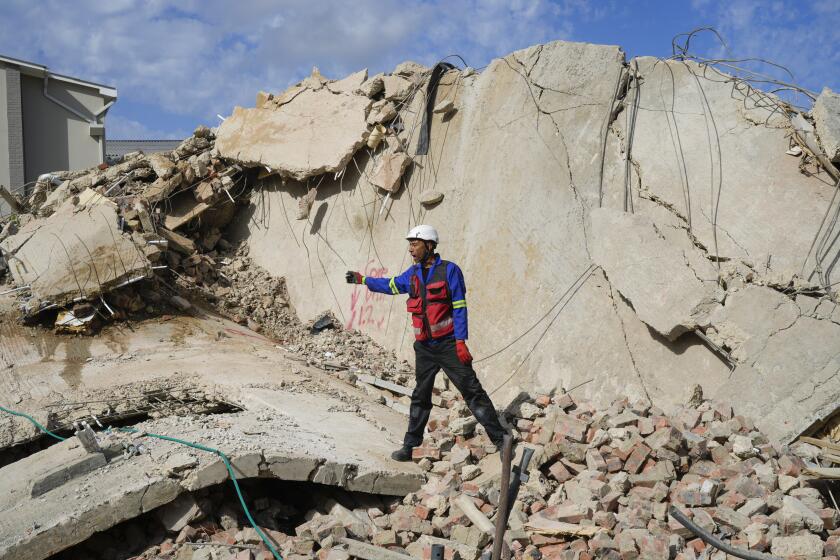Shoehorns in Hand, Mexicans Move Into Their Dream Homes
Maintenance worker Carlos Hernandez Pineda moved his family this year to one of several sprawling subdivisions rising here amid the alfalfa fields about 30 miles north of Mexico City.
He paid $15,700 for a row house with a living room, a kitchen, a bathroom and a single bedroom. It’s his sliver of the Mexican dream -- all 328 square feet of it.
Smaller than the typical U.S. two-car garage, the home could barely fit a pair of Hummers, much less the extended families that are common here. The kitchen is so narrow that the refrigerator sits in the living room, which also functions as the dining area and sleeping quarters.
Still, Hernandez has no buyer’s remorse.
“At least we’re not throwing away money on rent,” said the 38-year-old, who shares the dwelling with his wife, mother-in-law, twin daughters and pet dog Guero, whose name is Spanish for Whitey. “This is an inheritance for our girls.”
Hernandez is part of a wave of low-income Mexicans becoming first-time homeowners thanks to an aggressive government effort to make mortgages available to the working poor. Since President Vicente Fox took office in December 2000, more than 2 million Mexicans have obtained home loans, mainly through government-backed programs. That’s double the number achieved by Fox’s predecessor, Ernesto Zedillo, in his first five years in office.
With payments as low as $75 a month, young families are flocking to massive subdivisions being constructed by commercial builders on the outskirts of Mexican cities. Last year, developers built nearly 414,000 homes, a 66% increase from 2001. The most inexpensive units are as pint-sized and identical as Hernandez’s pigtailed 3-year-olds, Karla and Marlene.
Proponents hail the developments with their uniform facades and paved streets as a welcome alternative to the gritty shantytowns ringing many urban centers in Mexico. The boom has generated construction jobs and fueled sales of appliances and furniture. The stock prices of publicly traded home builders have soared. Many new homeowners who had been bunking with parents or renting in dicey city neighborhoods say they love the tranquillity of the suburbs.
But critics say these new communities, some of which include parks, businesses and schools, only add to Mexico’s unchecked sprawl, compounding the country’s notorious traffic and smog problems. The building boom certainly results in nightmarish commutes for many new homeowners such as Hernandez, who travels 2 1/2 hours by bus and subway to his job in the capital.
Some housing units are showing signs of wear months after their owners move in. That’s leading critics to question whether these tiny nest eggs will be worth much when their 30-year mortgages are paid off.
“We’re building the slums of tomorrow,” said Maria Teresa Esquivel, a sociology professor at the Autonomous Metropolitan University in Azcapotzalco. “The Fox administration likes to point to the large numbers of homes being built. But what about quality of life?”
Because mortgages from private banks are out of many Mexicans’ reach, the federal government has long been the engine of home lending. Fox put it into overdrive. He brought in a former banker to modernize the main housing agency, focusing on boosting lending to workers making less than $250 a month. The government has also channeled funds into specialized institutions that are reaching out to the self-employed and others who weren’t previously eligible.
Housing experts estimate that 600,000 mortgages will be issued this year, more than double the figure in 1999. The explosion in homeownership is hailed as the Fox administration’s most notable achievement.
Officials had to convince large builders that homes priced under $20,000 could be profitable. To gain economies of scale, companies are constructing thousands of bare-bones units. To save on materials and land, most of the homes have shared walls, compact floor plans and yards as small as 10 square feet.
The cheapest homes last year sold for about $16,500 and averaged 490 square feet of interior space, according to Softec, a housing consulting firm. That’s 14% smaller on average than in 2000. In contrast, the average U.S. home in 2004 was 2,349 square feet, up 4% over the same time period.
Proponents say the subdivisions are a vast improvement over squatter communities lacking roads, sewers and utilities.
But Pedro Leon, a professor of urban planning at the Autonomous Metropolitan University in Mexico City, said the government should be encouraging developers to revitalize established neighborhoods instead of developing elsewhere.
Leon said the low-cost units weren’t built to last. He doubts that many low-income homeowners will be able to afford routine maintenance, jeopardizing the appreciation many are banking on.
“They are buying an illusion,” Leon said.
Prospective homeowners don’t appear to share his concerns.
On a recent Sunday in Zumpango, young couples packed the sales office of Los Alamos, a 3,000-unit subdivision being constructed by Consorcio ARA, one of Mexico’s largest homebuilders. The semidetached houses with bright purple trim are priced at $18,500 to $31,000.
Marbella Rendon, 31, her husband and young son were among the first to move into the development in August. She said they loved their 800-square-foot, three-bedroom home in the quiet gated community abutting a field of grazing cattle.
“We feel safe here,” she said. “This is an investment for us.”
Homeownership has turned out to be more challenging than the Hernandez family expected.
To reach their home in the 4,000-unit La Trinidad subdivision, they travel along a two-lane country road lined with grazing sheep, cornfields and vendors selling fried carp from nearby Lake Zumpango.
Hernandez pays $110 to travel to and from work each month -- more than his $100 mortgage payment. Credit card bills and other loans the family racked up to furnish the place eat up much of what’s left of his $350 monthly salary.
To make ends meet, Hernandez’s wife, Edith Santiago Medina, operates an illegal grocery out of the front of the house selling snacks, bread and milk. Cash-strapped neighbors run similar businesses. Most have received letters from municipal officials threatening them with fines if they don’t stop.
The vacant house that appeared so cute seems cramped now that they have moved in. Lacking a closet, the family stores belongings in a single wardrobe. The kitchen table is brought inside only at mealtime. The foldout living room sofa doubles as a bed for Hernandez and Santiago. Her mother, Lucia, gets the bedroom. Daughters Karla and Marlene take turns, one sleeping with their parents and the other with Lucia. Guero is penned in an enclosed patio under an outdoor sink designed for washing clothes.
Asked how they’ll manage when the girls get older, Santiago replied: “I can’t worry about that until it happens.”
Hernandez admits that five hours of daily commuting is taking a toll. He sleeps fitfully most nights, fearful of missing the 4:30 a.m. jitney that takes him to Zumpango. From there, he catches another bus into Mexico City, followed by a long subway ride and a short walk to his maintenance job at a currency exchange. His 12-hour shift starts at 7 a.m.
Friday nights are the worst, when he often works late and doesn’t arrive back home until 1 a.m. Saturday.
Still, Hernandez says that providing for his daughters is worth the struggle.
“All I really want is a little more sleep,” he said.
More to Read
Start your day right
Sign up for Essential California for news, features and recommendations from the L.A. Times and beyond in your inbox six days a week.
You may occasionally receive promotional content from the Los Angeles Times.






